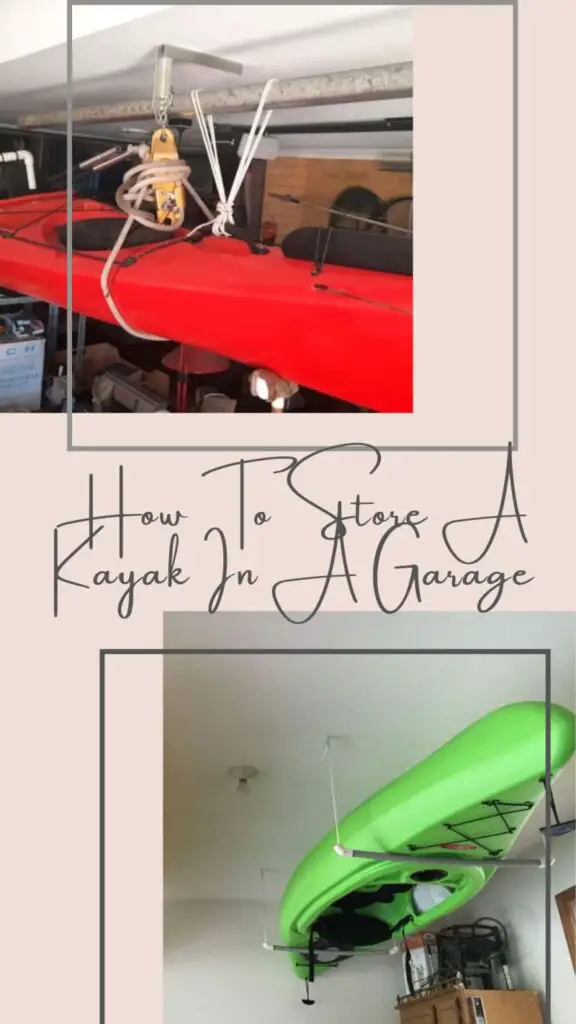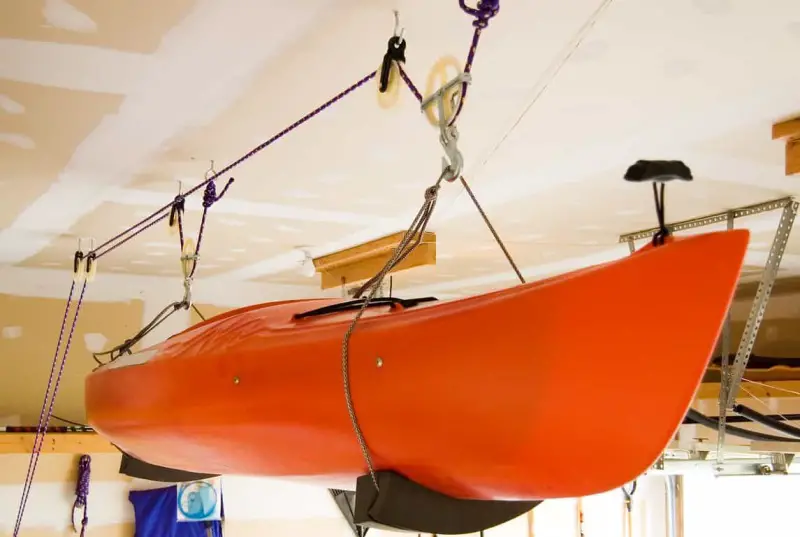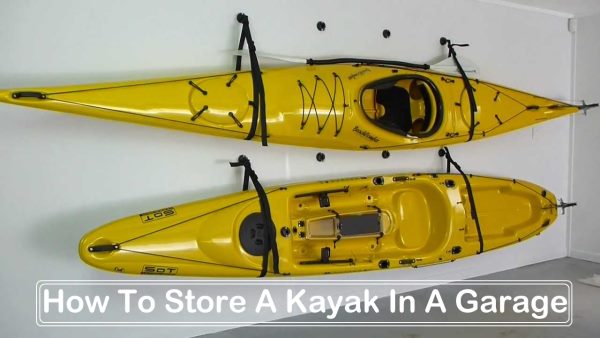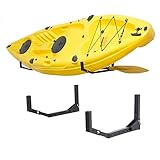The fall and winter season is approaching, a time when we will be going on kayaking trips less and less frequently. Lucky kayak owners who got themselves a new kayak this season should start thinking about where and how to keep their newly acquired equipment during the upcoming winter. Many kayak owners do not adequately prepare for the extra storage space their kayak will need. Proper kayak storage is just as important as purchasing the right kayak for your purposes.

There are many great techniques for storing kayaks outdoors (including building your own kayak storage shed), but many kayakers choose the advantages of indoor kayak storage. In the U.S. during the fall and winter, weather conditions vary so storing a kayak indoors is the best option. And the garage in most cases is best suited for storing large items such as a kayak.
In this article, we will present what we think are the best ways to store a kayak in the garage. We will also give you some general kayak storage tips that we advise you to follow no matter where you decide to store your kayak.
Table of Contents
Storing your kayak – Tips
1. Drain the remaining water from the kayak
Storing a kayak should never be done with the residual water in the cockpit or compartments. The exact method of draining your kayak of water will depend on the type of kayak you purchase.
In a sit-on-top kayak, you must open the drain plug, which is usually located at the bow or stern of the kayak. Then you must stand the kayak upright so that all the water inside drains out through the drain plug.
Regular kayaks that sit inside require the use of a bilge pump or sponge. You will have to pump most of the water out of the cockpit and bulkheads using them. Be sure to always store kayaks completely dry to avoid damage from freezing and thawing the water remaining in the kayak. When storing a kayak in a garage, this problem is not as significant, but most garages are not heated, so it is still recommended.
2. Clean your kayak thoroughly
There’s nothing worse than finding dirt and clutter in your kayak when you’re ready to load it onto your car and head out on a rafting trip. That’s why it’s always a good idea to thoroughly clean your kayak before storing it.
To clean your kayak, start by removing any materials, such as seat cushions or cargo hatch covers. These materials can usually be machine washed, but it’s always a good idea to read the manufacturer’s recommendations before doing so. Then wet the entire kayak with warm water mixed with a little liquid (such as soap). Use a sponge or scrub brush to thoroughly wash the kayak inside and out. After washing the kayak, rinse it thoroughly to remove all soap and any dirt. Open the drain plug or rotate the kayak to drain as much water as possible. At the very end, wipe the kayak with a dry towel and let it dry completely in the sun. Make sure the kayak is completely dry before placing it in the garage.
3. Keep the temperature and humidity as constant as possible
The best way to store your kayak in your garage and maximize its lifespan is to keep the temperature and humidity in your garage as constant as possible. I know that in many cases this is easier said than done. Most garages are not heated, which means that temperature fluctuations are huge depending on the season. Your garage probably gets very hot in the summer and cold in the winter. There are several things you can do to minimize these temperature fluctuations.
The first way (and probably the easiest) is to simply buy and run a small stove in your garage. Humidity can also pose a threat to your kayak, as excess moisture can cause some components to rust. For those who live in more humid environments, installing a dehumidifier in the garage is one way to reduce the effects of moisture on the kayak and its components. They require a bit more work than heaters, as you will have to regularly empty the water they remove from the air. With this in mind, maintaining a more consistent temperature and humidity in your garage is a great way to extend the life of your kayak and doesn’t necessarily require a huge investment of either time or money on your part.
The best ways to store a kayak in your garage
1. Wall rack for storing a kayak








Last update on 2024-04-23 / Affiliate links / Images from Amazon Product Advertising API
This way of storing a kayak needs a lot of wall space, but it’s a great way to store multiple kayaks in your garage without taking up floor space. With this kayak storage technique, you can store two or more kayaks in one section of the wall. However, when planning the space, be careful to save enough space to open the garage door.
If you’re a fan of DIY projects, a wall rack can be built relatively easily using PVC, wall mounting brackets, and PVC pipe joints. Of course, other materials can also be used. When deciding on a wall-mounted rack solution, always make sure that the rack arms are well-padded. This will help protect the integrity of the kayak in the long run. The main advantage of this storage solution is that it requires a one-time installation. It also provides a good permanent location to store your kayaks every time you bring them home from a trip.
2. Ceiling hanger for kayak storage
Last update on 2024-04-23 / Affiliate links / Images from Amazon Product Advertising API
Limited space in your garage means you have to get creative. A ceiling hanger is a great way to store kayaks in an area that would not be used in the garage anyway. Due to their complexity, it is generally recommended to purchase an overhead suspension system that includes all the required parts for proper installation.
As with the installation of a wall-mounted hanger, you need to make sure that your mounting hardware is firmly embedded in the wall. The only disadvantage of a ceiling hanger is the extra time and energy used in pulling and putting the kayak onto this storage system.
3. Storing the kayak in an upright position
Last update on 2024-04-23 / Affiliate links / Images from Amazon Product Advertising API
Kayaks can also be stored vertically in the garage so that they do not take up much wall space across the width. To use this method of kayak storage, you need a garage that is at least as tall (preferably at least 1 meter taller) as the length of your kayak.
This is a relatively easy solution for storing kayaks in a do-it-yourself garage, as it really only requires a few straps and secure wall brackets in which to anchor them. Of course, you’ll need to put something under the bow or stern of the kayak to protect it directly from the ground.
Such a vertical storage system can be installed relatively easily with D-Ring brackets (which will be attached to the garage wall) and two or three transport straps (to hold the kayak in place).
4. Wall mounting system
Last update on 2024-04-23 / Affiliate links / Images from Amazon Product Advertising API
Another wall-mounted solution is a set of slings, rather than installing fixed rack arms. This configuration still requires the installation of secure mounting hardware in the garage wall but relies on straps to secure the kayak.
The main advantage of this wall-mounted storage solution (compared to rack installation) is that it takes up much less space when the kayaks are not in the garage. This means fewer obstacles that can be encountered when the kayaks are moved. Another advantage of this type of storage solution is that some models can actually accommodate two kayaks with just one set of mounting hardware.
The only downside to storing a kayak in the garage using a carrier kit is the removal of the kayak. If you have a larger and heavier kayak, you may need someone to help hold the kayak while you loosen and unhook the straps.
5. Portable stand for storing a kayak
Last update on 2024-04-23 / Affiliate links / Images from Amazon Product Advertising API
Portable racks are by far the easiest solution for garage kayak storage. Although they take up more space than some other options, these racks are very easy to set up anywhere you want to keep your kayaks. Unlike wall- or ceiling-mounted solutions, these racks will require sufficient space in the garage. Typically, the amount of floor space needed can be measured using the dimensions of the kayak’s length and width. Portable racks are also great because they allow you to change where the kayak is stored. If you need to temporarily move the kayak outdoors, for example, while moving other things in the garage, it is very easy to move this type of kayak rack.
6. Freestanding stand
Last update on 2024-04-23 / Affiliate links / Images from Amazon Product Advertising API
A freestanding rack is a portable kayak rack. Often freestanding racks are less portable and so use them to store several kayaks at once. Therefore, they are very handy in some cases. These racks can easily be adjusted to fit your model kayak. The hooks can also be made adjustable to make room for adding multiple kayaks. As with all fixtures, there are drawbacks as well. It requires enough floor space to accommodate such a rack, especially when holding multiple kayaks. In addition, it is difficult and inconvenient to move it conveniently to get it out of the way if necessary.
Which way of storing a kayak is best for you?

Since not all garages are created exactly the same, the right solution for storing kayaks will ultimately depend on you. Here are some general recommendations.
If you have a lot of wall space, a wall-mounted kayak rack is probably the best solution. It’s a great way to store a kayak in a smaller garage where floor space is at a premium.
For those who have tall garages with a lot of unused space between the top of their vehicles and the garage ceiling, a suspension system is recommended. It’s also a really great solution for kayakers who only use their boats seasonally.
Storing kayaks vertically can be a great option for those with taller garages and less time to install equipment. It’s also great for kayakers who like to tinker and will create a kayak mounting kit with their own hands.
A wall-mounted carrier kit is ideal for anyone who doesn’t want a permanent kayak mount sticking out of the wall when the kayak is removed. It’s also a great option if you want to store multiple kayaks using one set of mounting hardware.
Finally, portable racks are best for anyone who anticipates moving their kayak frequently. It is also the only one of these five solutions that do not require mounting hardware.
Conclusion
The best way to store a kayak in the garage should be simple and economical. That’s why we’ve provided you with a list of easy solutions that can be implemented with relative ease. Whether you want to create your dream kayak storage system yourself or buy an inexpensive solution online, you have many options for storing your kayak. Simply follow the instructions that come with the equipment you purchase to protect your kayak investment!
Our best posts:





















